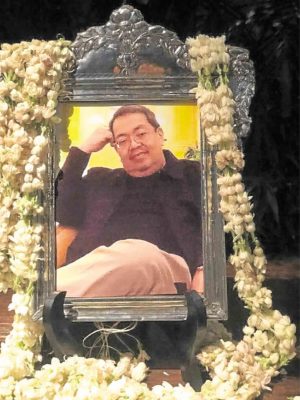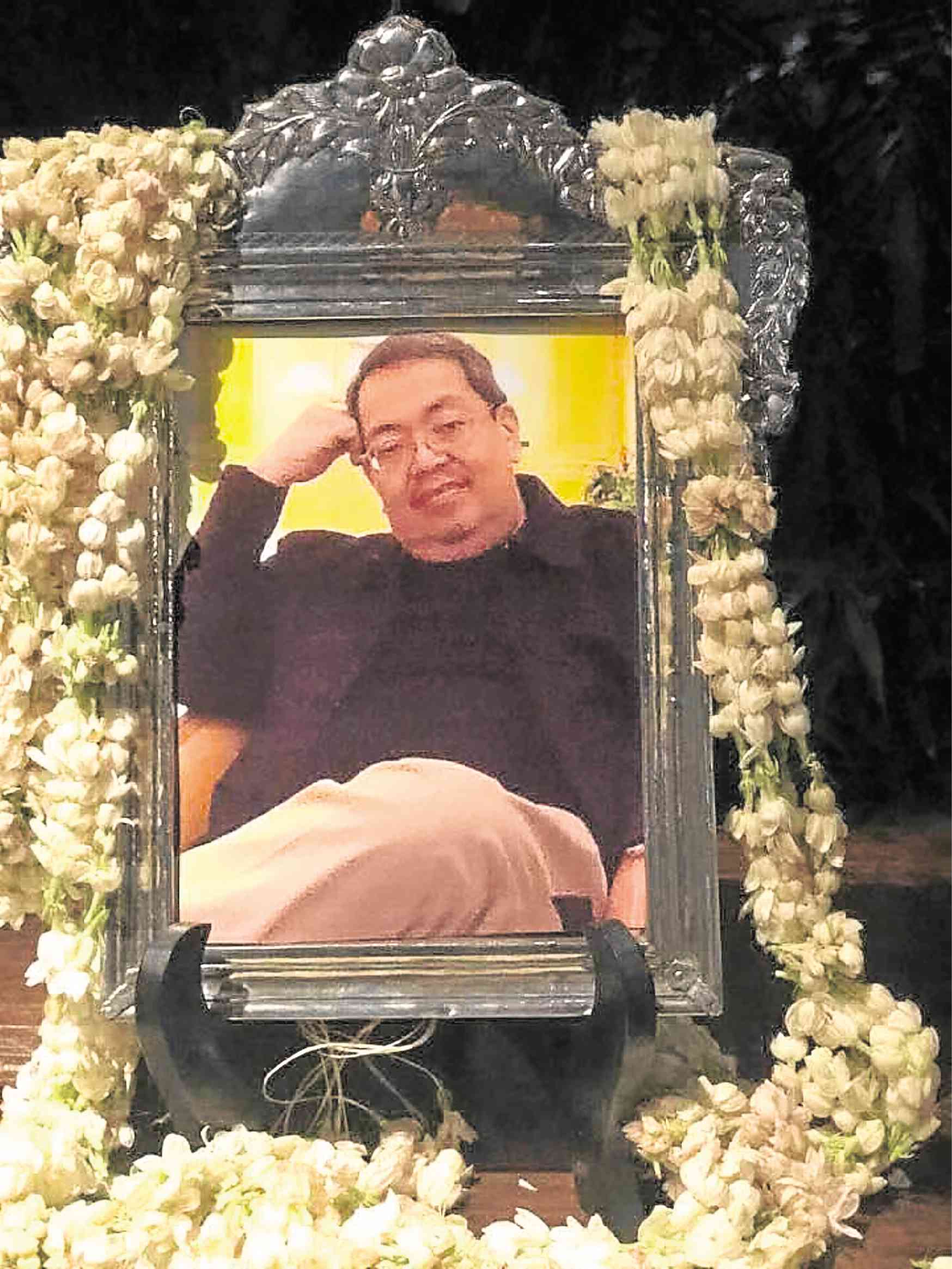
I feel orphaned!” said Vita Sarenas, her voice breaking. Vita is the doyenne of the influential Finale Art File gallery and is widely known as one of Ramon Villegas’ closest allies.
Ramon Villegas, lion of the Filipino world of art and culture, succumbed to a stroke last Aug. 11. He passed, as the expression goes, “with his boots on,” one mid-morning, tending to his jewelry store, Yamang Katutubo, at the La’O arcade, Makati.
“I don’t know what to do now! I would consult him on everything!” Vita wailed. That bewilderment and shock was exactly what united Manila’s antiquarians, scholars, historians, book publishers and journalists, and most of all collectors, big and small.
Ramon’s expertise, after all, spanned many categories—jewelry (precolonial to modern), furniture, Ifugao gods and Muslim ethnography, ivory saints, religious silver, turn-of-the-century paintings.
Ramon was also a bit of an expert on Filipino families, often knowing more about their bloodlines than the scions themselves.
Dark secret
I should know. The first time I got to chat with Boy—as Ramon was known to kin and friends—he mischievously blurted out, with that twinkle in his eye I later learned would always accompany the revelation of some dark secret: “You know, of course, you are descended from zacateros.” Zacateros provided the grass and hay necessary to feed the horses of Manila.
Boy comforted me by saying this was the equivalent of being a gasoline magnate, since horses were the 18th-century automobile.
“Oh, I wouldn’t argue about that as far as the Nakpils are concerned,” I replied. “We’re not blue bloods like my mother’s family, the Guerreros, but blue-collar workers from Quiapo—plateros (silversmiths) who became Katipuneros and so on.”
The reply seemed to satisfy Ramon, who grinned one of his Cheshire-cat smiles back at me. I would discover afterwards that he, as one astute observer put it, “had no love lost for society types.”
This was particularly astonishing because of his expertise in all their accoutrements—the gem-encrusted peinetas and tambourin, their legendary family homes and portraits, the lavish lifestyles of Manila’s de buena familia.
Ramon didn’t mind at all if you had a pedigree or not—provided, of course, he could mine you for any kind of information and, even better, if you were brimming with gossip, from any century.
Kit Roxas, one of his closest friends, confided to me the other day that Ramon in fact had “a communist relative… someone who was actually in jail, serving time. But I think he’s been let out now,” she whispered.
Apparently, Boy had actually lived for a year or two in the underground after he graduated from college. “He simply disappeared and later we found out he had, as they say, namundok,” said one close friend.
Ferocious reputation
Ramon’s most famous relative was none other than General Miguel Malvar, the last man to surrender to the Americans and the 2nd Supreme Commander of the First Philippine Republic of 1896.
That particular set of DNA explains a lot about Ramon’s character. Malvar would bend his knee to the new American masters only after they had systematically burned down whole towns in Batangas. And Ramon, despite his ferocious reputation and his unblinking opinions, was pretty much a kind heart with a soft touch.
At the wake, we discovered that he had been regularly paying off hospital bills of less fortunate friends and sending their children to school.
“I got to meet Ramon when we both had stores in Makati,” said Kit. Ramon had a store at Manila Garden Hotel and Kit had one at Quad, one of the first Makati malls, roughly where Greenbelt is now. “We were in the same business; I made it a point to meet him,” she said.
Did Ramon have any enemies, I asked in that sweet and sour tone that I had learned from him and perfected to a tee. Kit’s eyes widened and she broke into a broad smile. “Of course, he did! Quite a few!” she said. “He made lots of enemies because he always told the truth! I would tease him that I didn’t like going out with him since I was worried about being killed in an ambush.”
Jaime Ponce de Leon of León Gallery says that candidness “made working with him only easier.”
Good source
“I first met him sometime in 2008 or 2009,” recalled Jaime. “We were introduced by Mang Omeng Esguerra. After that first meeting, it became usual to consult him on various subjects from art to furniture, jewelry to objets d’art. Much later, when we got closer, he became a good resource for information on the social hierarchy and dynamics that is so important in the art world.
“Ramon was frank to a fault, and it wasn’t always easy to hear his opinions when he disagreed with you,” Jaime added. “But even when he would make mistakes, it was great to learn his historical rationale and justification for his thoughts. We collaborated on many projects, we published three books, and it was always fun to work together.”
Last book
Ramon’s last book, in association with León Gallery, was on the Philippine Art Gallery; and just two days before he was felled by that stroke, I met with him at La’O Center where he suggested the cover treatment and selected the pieces.
We were tittering about so-and-so government official’s delectable dilemmas and another famous lawyer’s fascinating couture wardrobe when a man carrying a painting appeared. Ramon stood up and entertained him politely, although he was clearly a stranger, and then delivered his professional opinion that the painting was not what it was purported to be.
The man’s face darkened and Ramon calmly continued to point out his reasons. The man would eventually storm out—to Ramon’s amusement—without a thank-you for the insightful information Ramon had so willingly shared.
After a few minutes, two or three other well-known collectors came in, some to shoot the breeze and find out the latest gossip—who sold what to whom, how much was paid, what delectable piece of art or silver or jewelry was on the market. Some others came to check on this or that piece that was in Ramon’s care for restoration.
Ramon was famous for these afternoon soirees, held daily unless he was away on some cultural sojourn—like organizing the influential Philippine exhibit at Paris’ Musée du quai Branly, or trawling regional centers during their art or jewelry fairs.
Influential collector
One immensely influential collector who would be at these tête-á-têtes without fail would shyly decline an interview on Ramon for this article. But one could read his high esteem of Ramon by the way he pulled out all the stops for Ramon’s ninth-day mass, decorating the memorial hall with gorgeous silver candelabra standing several feet tall, stunning ivory crucifixes and saints, all set against a hoard of vintage embroidered linen.
That collector also arranged for all of Ramon’s favorite classic Manileño food to be served in copious amounts, and picked up the tab.
Ramon had just finished editing the book “Likha: Enduring Legacies of Filipino Artistry (The Decorative Arts Collection of the Bangko Sentral ng Pilipinas).” He also contributed the essay “Filipino Jewelry during the Colonial Era” for the same publication.
At his wake, it was announced that the book had won an important prize. Jaime Laya, former governor of the Central Bank of the Philippines and instrumental in building the bank’s immense cultural holdings, also recalled that he first met Ramon in the course of commissioning the first books for the Central Bank. (This would be the notable “Kayamanan: The Philippine Jewelry Tradition,” published in 1983.)
A fourth-generation jeweler, Ramon was, according to his kilometric resumé, officially “an antiquarian and gallerist.”
But he was certainly more than the sum of those parts. —CONTRIBUTED









































